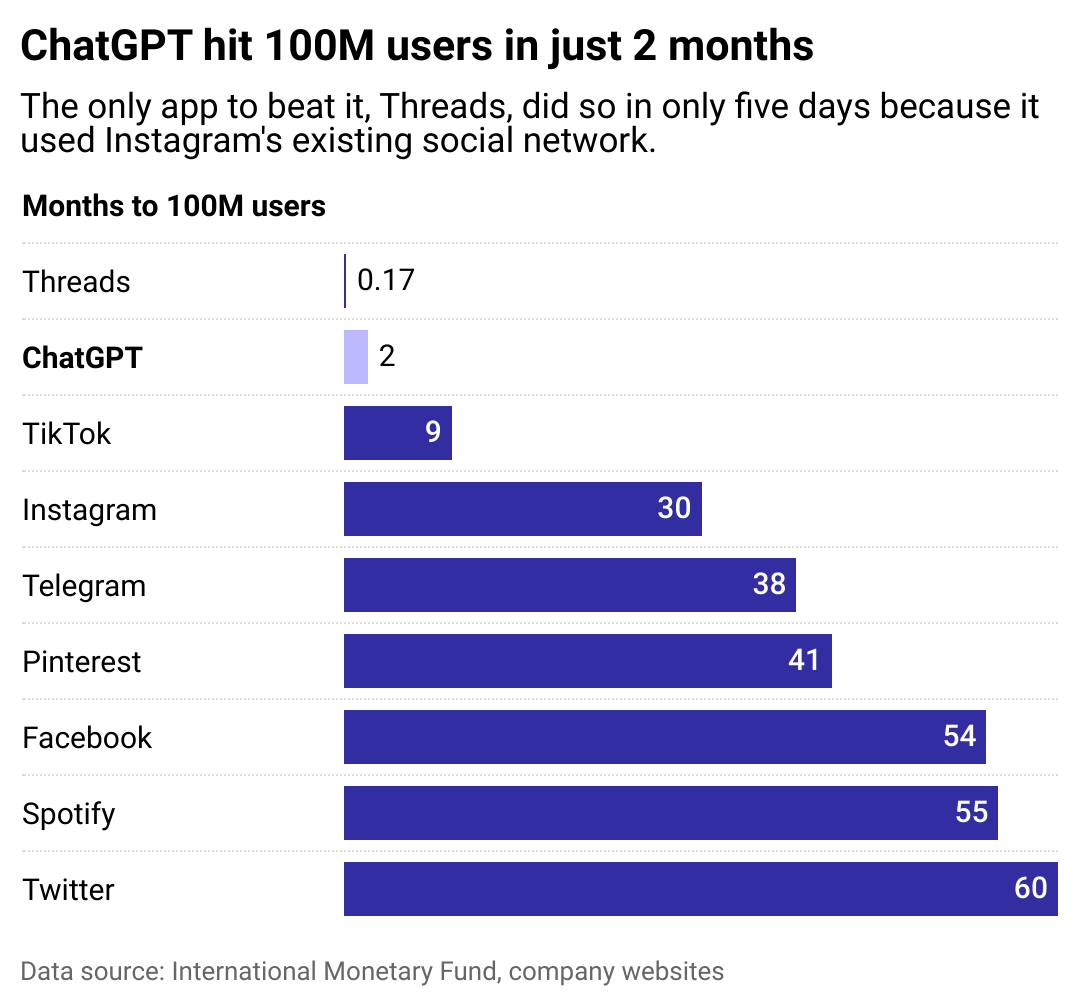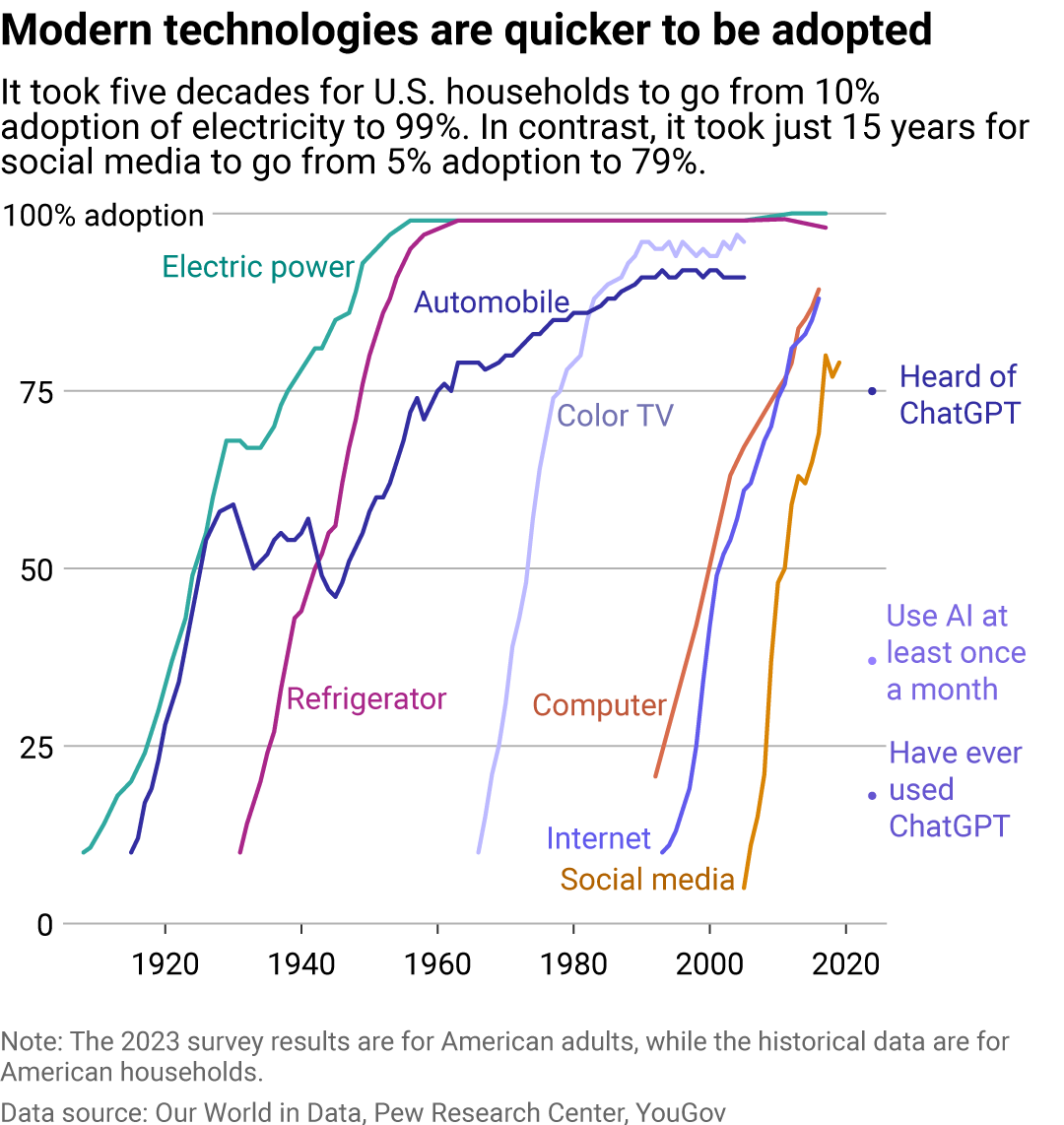How quickly are consumers and businesses adopting AI tools compared to past technologies?
Gorodenkoff // Shutterstock
How quickly are consumers and businesses adopting AI tools compared to past technologies?
Young woman with curly hair on computer.
The buzz over artificial intelligence is everywhere you look right now, with the rate of adoption understandably turning heads.
ChatGPT hit the streets in November 2022; by January, the tech set a record as the fastest-growing consumer application with 100 million users and hardly any marketing. But ChatGPT is just one of several wildly popular AI tools in use today.
AI generally refers to the discipline of building machines and programs that can perform tasks and solve problems in the same way as a human might. The history of AI is almost as old as digital computers themselves.
Businesses are clamoring—with varying rates of success—to experiment with how processes and roles can be augmented or completely automated by artificial intelligence tools such as ChatGPT, its competitors, and function and industry-specific AI tools.
Factory automation disrupted manual and blue-collar jobs as far back as the flour mill in the 18th century. This technology exploded in the 20th century with robots on assembly lines. AI is now similarly beginning to disrupt the job market, this time for entry-level roles in white-collar industries.
It’s not that all knowledge worker jobs will be replaced by AI. In many cases, AI will serve as a co-pilot of sorts, helping workers complete tasks more quickly. However, knowing how to use AI will become a requirement. Within a few years, workers who know how to use AI will replace those who don’t.
ChatGPT’s rapid rise reflects two broader trends. For one, tech is being adopted more quickly these days. The adoption curve for other technologies, from the internet to social media, has been nearly a vertical line. The adoption of ChatGPT was even more meteoric, with businesses paying particular attention to how AI can improve processes and bring down costs. If various elements of a single job can be done by AI, it’s only a matter of time before the technology can account for entire roles.
To compare AI’s traction with that of past technologies, Verbit analyzed data from the International Monetary Fund, Our World in Data, the Pew Research Center, and YouGov, among other sources.
OpenAI, Google, Amazon, and other tech companies competed in 2023 to introduce a variety of AI and generative AI tools. The technology—which in years past might have been kept in the sphere of academics, contractors, and secret development programs—was placed in the hands of everyday consumers.
No tech company wanted to be left behind, and these models improve based on their interaction with users. Despite its fair share of hiccups and “hallucinations,” enthusiasm for AI turned the technology into one of the hottest technological developments in recent history.
The deluge of AI tools in the last two years resulted in some stunning developments, such as the capability to generate high-quality text and images. The real magic comes from how computers can now match or exceed average human abilities during testing when it comes to image and text recognition. This is propelled by advances in “deep learning” technologies, in which computer programs utilize multiple synthetic “neural networks” to analyze inputs and generate high-caliber text and images.
Other popular AI tools include image generation tools such as Dall-E and Midjourney, which can generate images from textual descriptions; translation tools such as Google Translate; and even coding assistance tools such as GitHub, CoPilot, and Codeium.
![]()

Verbit
ChatGPT was the fastest-growing app when it first launched
A bar chart showing how long it took various apps to hit 100 million users. It took ChatGPT just two months, compared with 60 months for Twitter.
The user growth for ChatGPT has been staggering. The service reached 100 million users in two months, faster than any consumer-facing app before it. The only service to beat it since was Meta’s Threads, a social media platform similar to X (formerly Twitter). Launched in July 2023, Threads received a huge boost from being able to market across Facebook’s 3-billion-plus monthly active users.
The service being free and available to the public certainly boosted ChatGPT’s success. It was also among the first pieces of AI with easy-to-understand inputs and outputs. You didn’t have to be a pro to use it: You just had to type an English command into a simple text box, and completely comprehensible text was returned.
Organic word-of-mouth played a major factor, as well. Users racked up likes and shares for posting novel pieces of AI-generated text based on surprising combinations. In one instance, ChatGPT penned instructions for removing a peanut butter sandwich from a VCR in the style of a Bible verse. People also began sharing examples of productive, real-world applications, from writing a school essay to summarizing long articles and studies and automating business processes. Thinking of the time- and money-saving possibilities, people’s imaginations took off—and viral growth followed.

Verbit
Digital technologies are spreading more quickly than ever before
A line chart showing how long it took for various technologies to hit mass adoption in the U.S. It took decades for inventions such as electricity or the automobile to become universal, but digital technologies proliferate in just years.
The rate of technological adoption is speeding up, aided by other technologies that make information-sharing and widespread use more accessible to the masses.
Landlines were introduced in the United States in 1903; by 1946, they were in just half of all American households. By contrast, the same penetration of cellphones only took eight years. This begs the question: Will AI’s spread and adoption be even faster?
Despite the excitement and widespread experimentation, we have yet to see entire industries transformed by artificial intelligence. This could be because we are in an intermediate period known as a “J-curve,” a period of time when productivity promises of new technology aren’t immediately realized as companies figure out how to reinvent themselves and develop new processes that incorporate the novel development.
Observers caution that some of the AI hype is overblown and misses the big picture: that there are specific (and limited) use cases for AI and machine learning. Certain fields are more ripe for disruption, such as those relying on the synthesis, digestion, and analysis of high volumes of data. Certain responsibilities in legal, engineering, design, and writing fields are more likely to have lower functions automated. However, professions requiring manual performance, such as dishwashing, athletics, or the skilled trades of carpentry and welding, aren’t as susceptible to having their core functions automated.
Story editing by Nicole Caldwell. Copy editing by Tim Bruns.
This story originally appeared on Verbit and was produced and
distributed in partnership with Stacker Studio.

